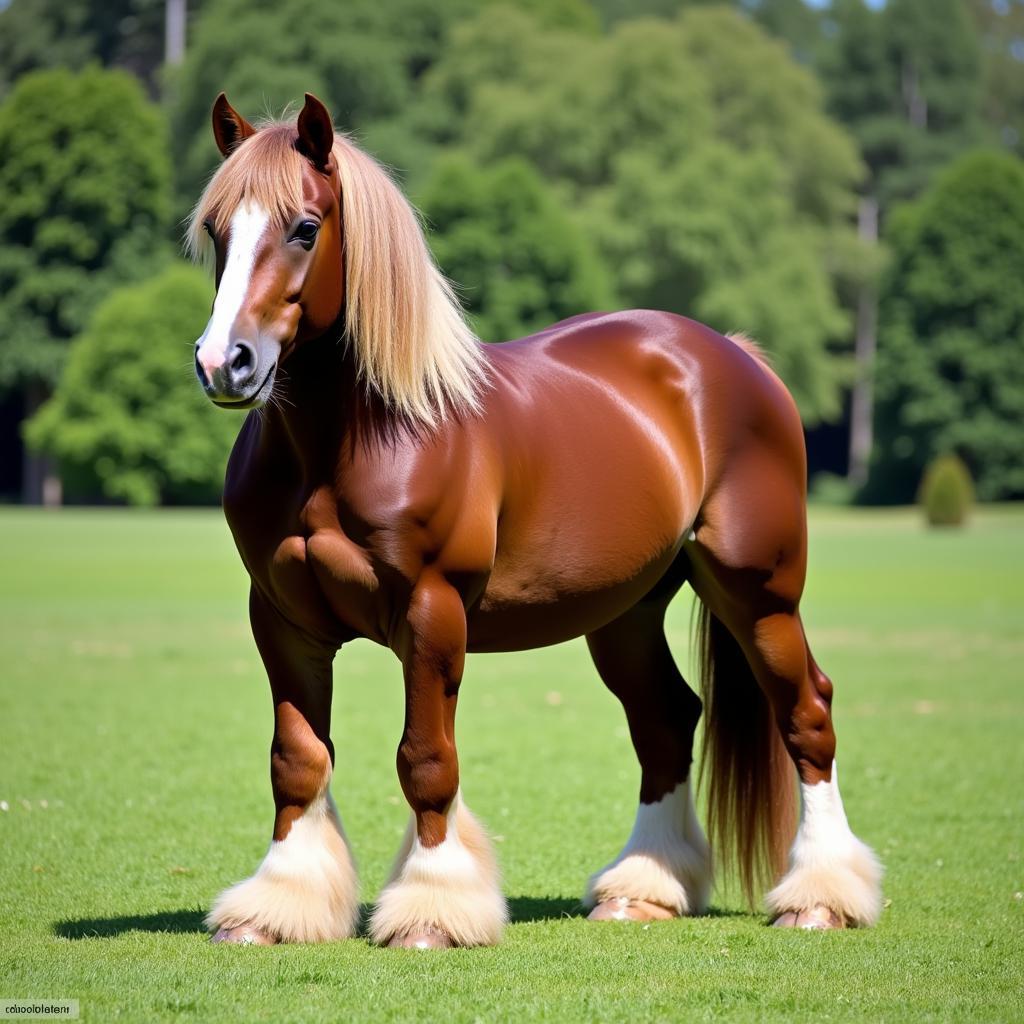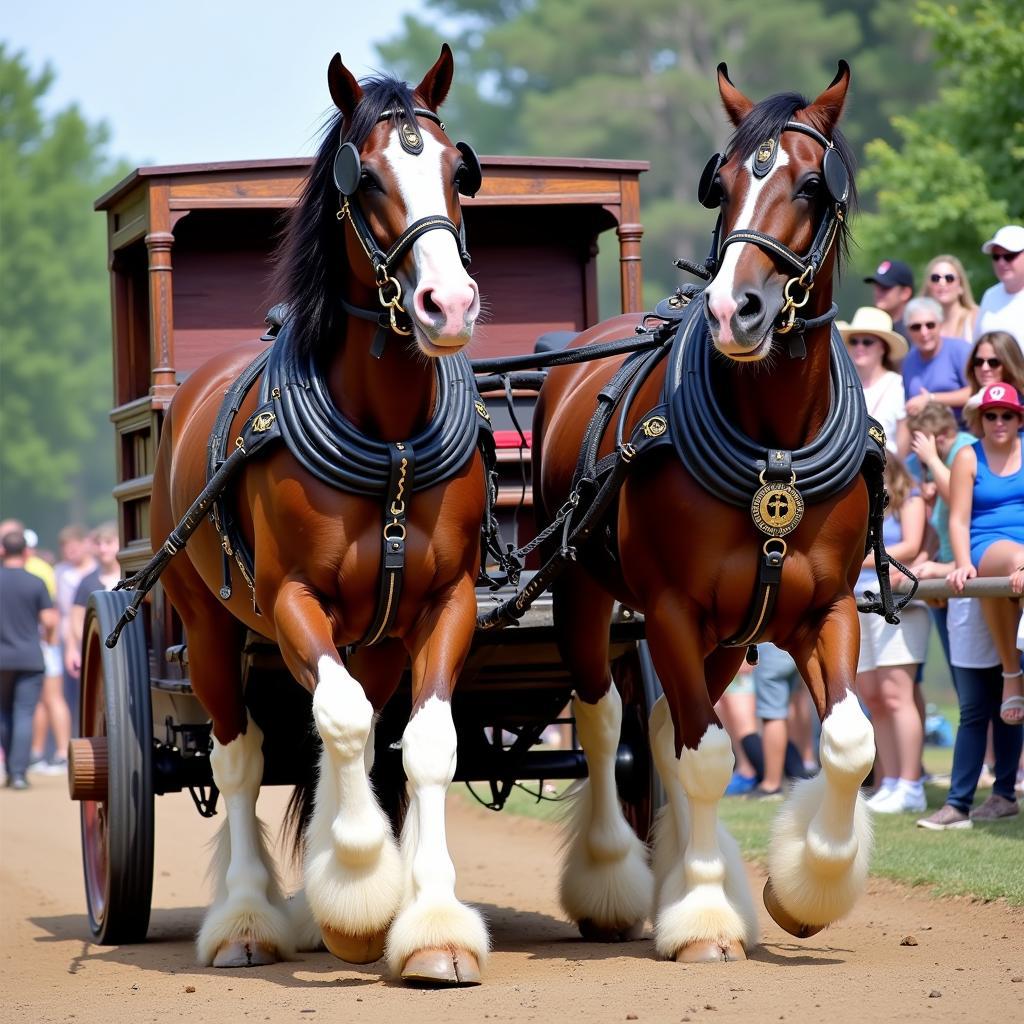The Clydesdale horse, with its striking feathered feet and imposing size, is an unforgettable sight. But how do these gentle giants compare to a “normal” horse, and what sets them apart? This article delves into the key differences and similarities between Clydesdale horses and other breeds, exploring their history, temperament, uses, and care requirements.
 Clydesdale horse standing in a field
Clydesdale horse standing in a field
A Look Back at the Clydesdale’s Origins
The Clydesdale breed originated in Lanarkshire, Scotland, taking its name from the River Clyde. Bred as powerful draft horses, Clydesdales were essential for agriculture and transportation in the 18th and 19th centuries. Their strength and stamina made them ideal for plowing fields and hauling heavy loads, contributing significantly to Scotland’s industrial revolution.
Size and Appearance: A Giant Among Horses
One of the most notable differences between a Clydesdale horse and a “normal” horse is size. Clydesdales are classified as draft horses, meaning they are bred for power. A “normal” riding horse, such as a Thoroughbred or Quarter Horse, typically stands between 14 and 17 hands high (56-68 inches) and weighs between 900 and 1,200 pounds. In contrast, a Clydesdale horse can reach an impressive 16 to 18 hands (64-72 inches) high and weigh between 1,800 to 2,300 pounds.
Beyond their towering height and weight, Clydesdales are known for their distinctive features:
- Feathered Feet: Abundant feathering, or long hair, covers their lower legs, flowing over their hooves like a soft curtain.
- Bay Coat: While Clydesdales can come in other colors, the most common is bay—a brown body with a black mane, tail, and lower legs.
- White Markings: Many Clydesdales sport striking white markings on their faces and legs, adding to their majestic appearance.
Temperament: Gentle Giants with a Willing Spirit
Despite their size, Clydesdales are known for their calm and willing temperaments. Often referred to as “gentle giants,” they are intelligent, eager to please, and form strong bonds with their handlers. This gentle nature makes them well-suited for various disciplines beyond traditional draft work.
Clydesdale vs. Normal Horse: Uses and Disciplines
While their history lies in heavy work, Clydesdales today participate in a diverse range of activities:
Clydesdales:
- Draft Work: Many Clydesdales still engage in traditional draft work, such as plowing, logging, and pulling carriages.
- Showing: Clydesdales excel in the show ring, captivating audiences with their movement and presence in halter, harness, and riding classes.
- Therapy Work: Their gentle disposition and impressive size make Clydesdales ideal therapy animals, bringing comfort and joy to those in need.
“Normal” Horses:
- Riding: Most “normal” horse breeds are bred for riding, encompassing disciplines like English riding, Western riding, dressage, and jumping.
- Racing: Thoroughbreds and Quarter Horses are renowned for their speed and agility, dominating the world of horse racing.
- Therapy Work: Smaller horse breeds, like the Miniature Horse, also play a vital role in therapeutic riding programs.
 Clydesdale horse pulling a cart
Clydesdale horse pulling a cart
Caring for a Clydesdale: Meeting Their Unique Needs
Owning a Clydesdale is a significant commitment. Their sheer size means they require more food, water, and space than a “normal” horse. Their feathered feet, while beautiful, need meticulous care to prevent skin issues and thrush.
Here’s what you need to know about caring for a Clydesdale:
- Nutrition: Clydesdales need a high-quality diet of hay, grain, and supplements to support their size and energy levels.
- Housing: A spacious stall with ample bedding is crucial, along with daily turnout in a large pasture for exercise and grazing.
- Hoof Care: Regular farrier visits are essential to trim their hooves and maintain the health of their feathered feet.
- Veterinary Care: Like all horses, Clydesdales need routine veterinary care, including vaccinations, deworming, and dental checkups.
Conclusion: Appreciating the Majesty of the Clydesdale
While both Clydesdale horses and “normal” horses hold a special place in the equine world, their unique characteristics set them apart. Clydesdales, with their imposing size, gentle spirits, and striking appearance, embody strength and grace. Understanding their specific needs and appreciating their historical significance allows us to admire these magnificent animals fully.
If you’re interested in learning more about Clydesdale horses or other unique breeds, contact Justus Horses USA at 0772127271, email us at [email protected], or visit us at QGM2+WX2, Vị Trung, Vị Thuỷ, Hậu Giang, Việt Nam. Our team is available 24/7 to answer your questions and connect you with the resources you need.